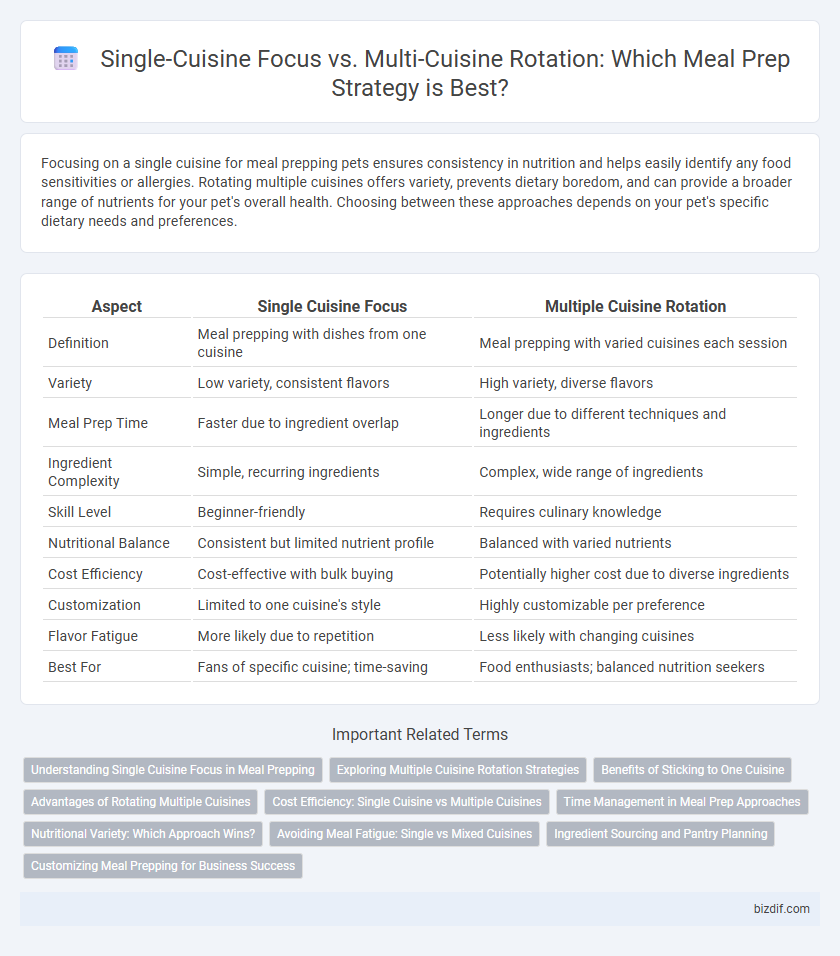Focusing on a single cuisine for meal prepping pets ensures consistency in nutrition and helps easily identify any food sensitivities or allergies. Rotating multiple cuisines offers variety, prevents dietary boredom, and can provide a broader range of nutrients for your pet's overall health. Choosing between these approaches depends on your pet's specific dietary needs and preferences.
Table of Comparison
| Aspect | Single Cuisine Focus | Multiple Cuisine Rotation |
|---|---|---|
| Definition | Meal prepping with dishes from one cuisine | Meal prepping with varied cuisines each session |
| Variety | Low variety, consistent flavors | High variety, diverse flavors |
| Meal Prep Time | Faster due to ingredient overlap | Longer due to different techniques and ingredients |
| Ingredient Complexity | Simple, recurring ingredients | Complex, wide range of ingredients |
| Skill Level | Beginner-friendly | Requires culinary knowledge |
| Nutritional Balance | Consistent but limited nutrient profile | Balanced with varied nutrients |
| Cost Efficiency | Cost-effective with bulk buying | Potentially higher cost due to diverse ingredients |
| Customization | Limited to one cuisine's style | Highly customizable per preference |
| Flavor Fatigue | More likely due to repetition | Less likely with changing cuisines |
| Best For | Fans of specific cuisine; time-saving | Food enthusiasts; balanced nutrition seekers |
Understanding Single Cuisine Focus in Meal Prepping
Single cuisine focus in meal prepping streamlines ingredient shopping and simplifies cooking processes, enhancing efficiency and reducing food waste. Concentrating on one cuisine allows for deeper flavor mastery, consistent meal quality, and easier portion control. This approach benefits those seeking routine, budget-friendly meal solutions with minimal kitchen complexity.
Exploring Multiple Cuisine Rotation Strategies
Exploring multiple cuisine rotation strategies in meal prepping enhances dietary variety and broadens nutrient intake, promoting balanced and enjoyable meals throughout the week. Incorporating diverse ingredients and cooking methods from various global cuisines prevents meal fatigue and supports sustained motivation to maintain healthy eating habits. Strategic planning of multiple cuisine rotation enables efficient use of leftovers and seasonal produce, optimizing both time and budget in meal preparation.
Benefits of Sticking to One Cuisine
Focusing on a single cuisine during meal prepping streamlines ingredient shopping and reduces food waste by allowing better use of staple items. It enhances culinary skills and mastery of specific flavor profiles, contributing to more consistent and enjoyable meals. Concentrating on one cuisine also simplifies meal planning and saves time by minimizing recipe research and preparation complexity.
Advantages of Rotating Multiple Cuisines
Rotating multiple cuisines in meal prepping enhances nutritional variety by incorporating diverse ingredients and essential nutrients, reducing the risk of dietary monotony and nutrient deficiencies. It also increases culinary creativity, keeping meals exciting and preventing palate fatigue, which supports better long-term adherence to healthy eating habits. Exposure to different cultural flavors enriches the eating experience and broadens cooking skills, making meal prep more enjoyable and sustainable.
Cost Efficiency: Single Cuisine vs Multiple Cuisines
Focusing on a single cuisine for meal prepping often reduces cost efficiency by enabling bulk purchasing of specific ingredients, lowering overall grocery expenses. Multiple cuisine rotation may increase ingredient variety and complexity, potentially raising costs, but allows for better use of versatile staples that minimize food waste. Cost efficiency hinges on balancing ingredient overlap across cuisines with strategic shopping and portion control.
Time Management in Meal Prep Approaches
Focusing on a single cuisine during meal prepping simplifies ingredient selection and cooking processes, saving significant time by reducing meal variation complexity. Rotating multiple cuisines requires more planning and ingredient diversity, potentially increasing prep time but offering nutritional variety and reduced menu fatigue. Efficient time management in meal prep depends on balancing convenience of single cuisine focus with the creativity and dietary benefits of multiple cuisine rotation.
Nutritional Variety: Which Approach Wins?
Single cuisine meal prepping offers consistency and ease in tracking macronutrients but may limit exposure to diverse vitamins and minerals. Multiple cuisine rotation enhances nutritional variety by incorporating a wider range of ingredients, supporting balanced intake of micronutrients and phytochemicals essential for overall health. Prioritizing multiple cuisines in meal prep maximizes dietary diversity and nutrient density, promoting better long-term wellness outcomes.
Avoiding Meal Fatigue: Single vs Mixed Cuisines
Choosing a single cuisine for meal prepping simplifies ingredient shopping and enhances flavor consistency, but risks meal fatigue due to repetitive tastes. Rotating multiple cuisines introduces diverse flavors and nutrients, helping maintain interest and balanced nutrition over time. Strategic planning of mixed cuisines can optimize meal variety while minimizing preparation complexity.
Ingredient Sourcing and Pantry Planning
Single cuisine focus streamlines ingredient sourcing by allowing bulk purchases of specialized staples, reducing waste and optimizing pantry space. Multiple cuisine rotation requires a diverse pantry inventory, demanding strategic planning to balance perishable and non-perishable items for varied meal options. Efficient pantry organization tailored to the culinary approach enhances meal prepping efficiency and ingredient freshness.
Customizing Meal Prepping for Business Success
Focusing on a single cuisine in meal prepping allows businesses to streamline ingredient sourcing and perfect signature dishes, enhancing brand identity and operational efficiency. Rotating multiple cuisines appeals to diverse customer preferences, boosting market reach but requires agile supply chain management and recipe standardization. Customizing meal prepping strategies to balance consistency with variety drives customer satisfaction and sustainable business growth.
Single Cuisine Focus vs Multiple Cuisine Rotation Infographic

 bizdif.com
bizdif.com